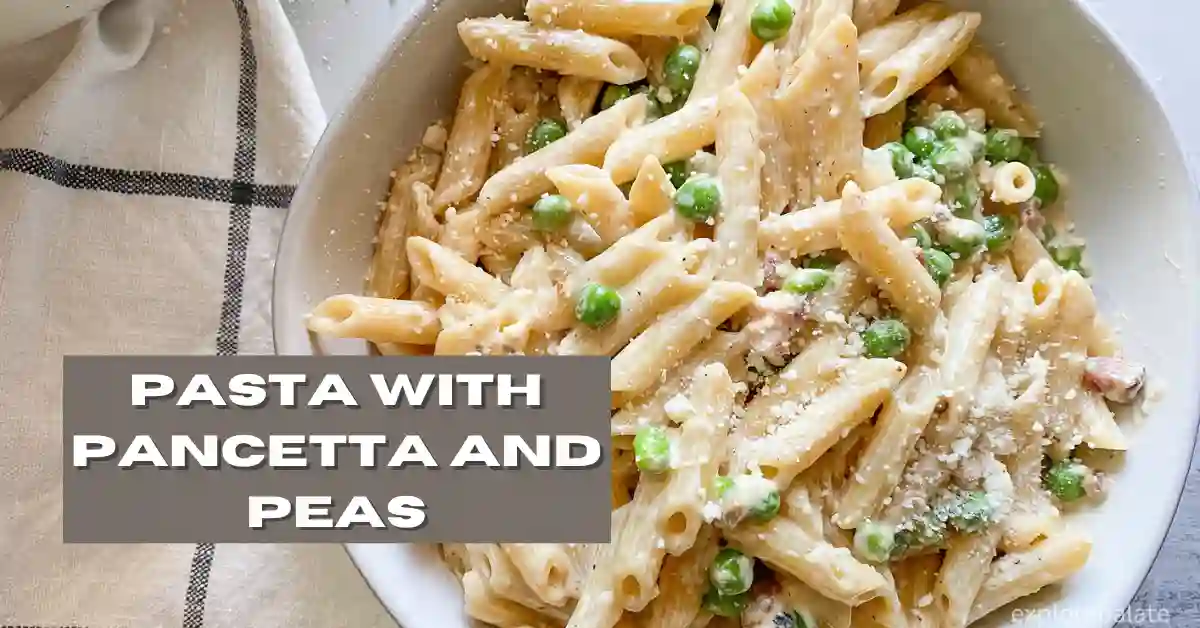During the weekends, when the heart pines for something comforting, a quick and easy Creamy Parmesan Pasta with Pancetta and Peas becomes the perfect nightcap. Imagine a dish that brings the salty crisps of pancetta and sweet bursts of peas together in a velvety cream sauce; it’s the classic dinner that any family would declare a favorite.
My fond memories of this simple yet delicious dish trace back to the weeknight meals back home in Atlanta, a comforting hug in every bite. Though I’ve been heartsick for my hometown while setting down roots in New York City, this recipe eases the homesickness, encapsulating the nostalgia of the family dinners and the minimal prep and effort they require after a long day.
In New York, a city where food occupies my thoughts nearly 24 hours a day, my heart holds a special place for Elio’s, an entire tiny gem in the Upper East Side. On their menu, there’s a dish they don’t always advertise – an out-of-this-world pasta similar to the one served in my favorite old-school Italian joints for years. Known among those who know to ask as “Elio’s Pasta,” it encompasses house-made, light angel hair pasta, a silky, luscious parmesan cream, salty yet crisply fried pancetta, and sweet, fresh peas.
The entire experience is a straightforward yet transformative dining experience, showcasing that the best dishes don’t need a long list of components, just a handful of good quality ingredients and a whole lot of love. My recreation of this perfect plate pays homage to that beloved Italian restaurant, the product of a time spent living and learning the ropes of Italian cuisine with French technique, true comfort food that staves off bites of nostalgia and replaces them with satisfying comfort
What Is Pasta With Pancetta And Peas?

Pasta with pancetta and peas is a cream-based pasta dish packed with flavor that can be served both as a main course or a side. This exquisite recipe combines the rich taste of salty pancetta and the sweet freshness of peas, all enveloped in a velvety cream sauce. It’s an easy yet sophisticated dish that is much enjoyed because of its simplicity and depth of flavor.
Often, I find myself reminiscing the times when this dish graced our dinner table, bringing a warm sense of conviviality and satisfaction. Whether for an intimate family gathering or a more casual meal, people around the globe have become enamored with its straightforward yet comforting appeal.
Creamy pasta with pancetta and peas name
In my earlier years at culinary school, where I found my mentor in the dean, Chef Cesare Casella, a renowned Michelin-starred chef, we often experimented with American-Italian cuisine, leading to many inventions. One such creation that reminds me of this pasta is the cacio e pepe, though our dish’s true heritage lies closer to a carbonara without the eggs.
It’s a homely dish that I’ve learned to marry different ingredients together akin to the classic Elio’s Pasta. In fact, it’s only upon returning home one day to recreate it with what was on hand did my rendition of the dish receive an official labeling from delighted friends as “The Creamy pasta with pancetta and peas.” It’s a dish that celebrates the beauty of Italian cuisine with every forkful of its comforting embrace.
What Is Pancetta?
Hailing from Italian culinary roots, pancetta is often known as Italian bacon, made from pork belly. Unlike its bacon counterpart, pancetta is cured but not smoked, which imparts a distinct salt and spice profile that adds rich flavor and a crisp texture to various dishes. My personal touch to the traditional pastas, soups, and sauces is to add some pancetta, bringing depth to the recipe that’s surprisingly safe to eat raw, although cooking it is far nicer.
When I weave pancetta into my Creamy Parmesan Pasta with Pancetta and Peas, its air-dried, fattier edges lend a flavor that becomes the star of the show, lifting the humble peas to a level of comfort synonymous with the outside cafés of Italy. While bacon could be used, the pancetta’s distinct texture and flavor, achieved by curing with spices and salt, make it a precursor to a perfect Italian dish.
To bring out the best in pancetta, I always ensure it is cooked to a crisp; however, it’s entirely safe to eat raw in recipes where it is similarly thinly sliced and complemented by other ingredients.
Pancetta vs bacon
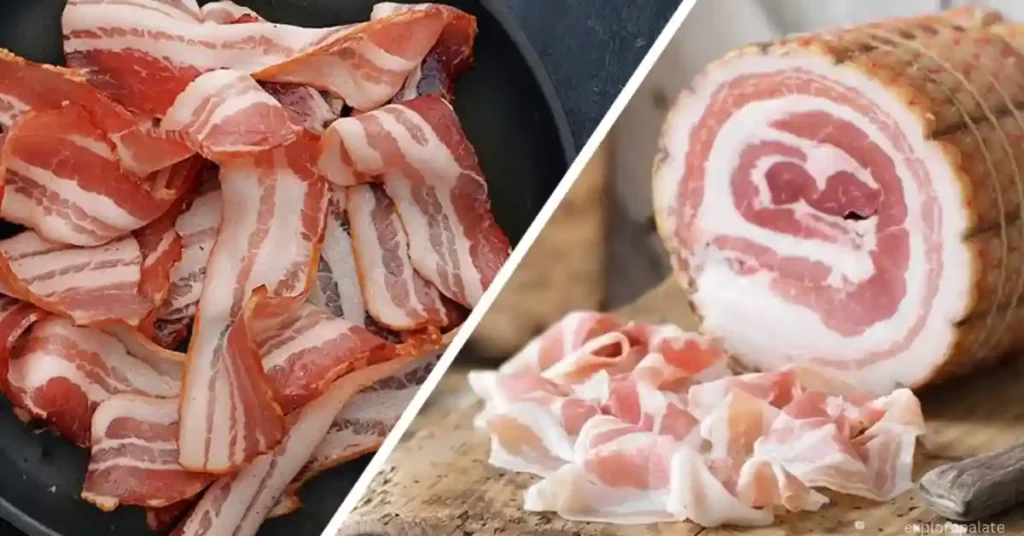
Venturing into the great debate of pancetta vs bacon, here I am after years of exploring textures and flavors, ready to impart the difference between these two staples. Both originate from the pork belly, but pancetta is cured whereas bacon is both cured and smoked. This creates a distinct difference in their profiles: pancetta boasts a rich, flavorful edge that elevates a dish subtly, while bacon brings a woodsier flavor owing to the variety of woods it’s smoked with.
As I’ve experimented with both in my cooking escapades, the choice hinges on whether the complimentary flavors of smoke or a crisp, purely cured essence would benefit the dish at hand. In my recipe of a creamy parmesan pasta, the distinct texture and the richness of pancetta melds exquisitely with the parmesan’s nuttiness and the peas’ sweetness, a match that would be overshadowed by the smokiness of bacon.
What pasta shape is best?
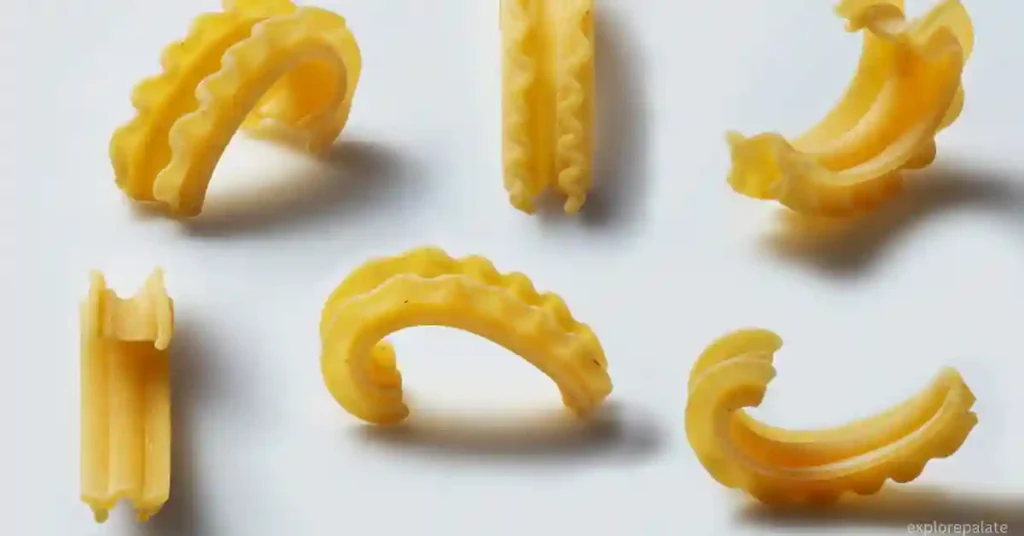
Fusilli
Fusilli – short, twisty, and beloved for capturing bits and pieces of peas and pancetta in its curves, it’s undeniably a favorite in recipes like this. Longer shapes like pappardelle or spaghetti tend to overshadow the mix-ins, but fusilli allows every forkful to mix through a balanced bite.
Handmade Shape
The hand-rolled, handmade shape – like orecchiette or gnocchi sardi – might not be the dried shape you reach for in every recipe, but it harbors a delicious homey touch. It cradles the creamy bacon pasta sauce like no other, turning a similar base of vegetables and pancetta into a completely different, yet equally easy, experience compared to say, a cacio e pepe with a dash of olives and basil.
Ingredients Needed To Make This Creamy Pasta With Pancetta And Peas Recipe
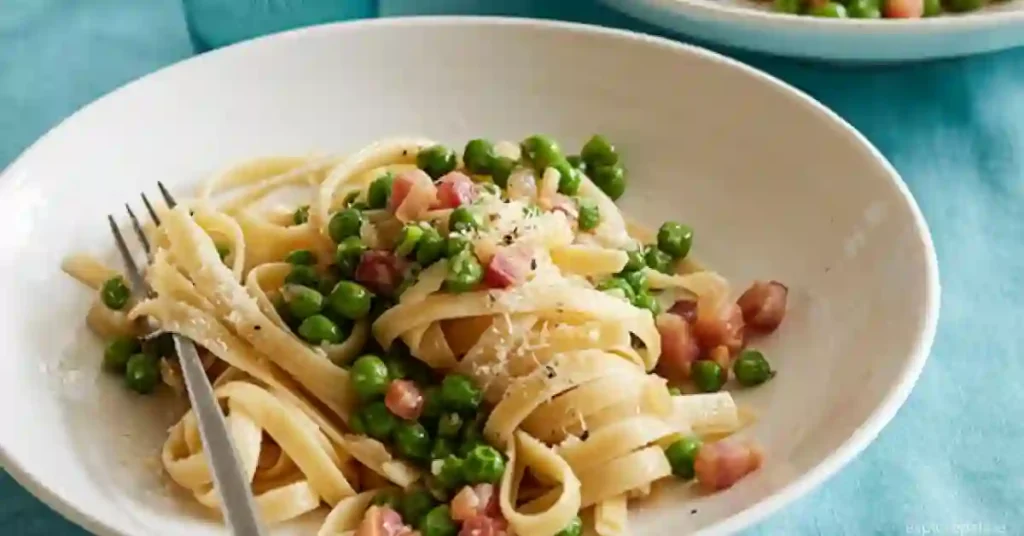
Pasta
Whether you choose delicate angel hair, bowtie-shaped farfalle, spiraled cavatappi, or ridged rigatoni, each offers its unique charm. But don’t overlook the orecchiette; it has an uncanny ability to cradle the sauce and pancetta.
Pancetta
The thick-cut, diced pancetta should sizzle to the point of crisp perfection, it’s the contrast in textures that elevates the dish.
Peas
Frozen or fresh, petite peas add a sweet pop to the creamy tableau, complementing the salty pancetta with their freshness.
Scallions and shallots
Scallions and shallots bring an aromatic savoriness, contributing subtle freshness that can’t be overstated.
Heavy cream
The heavy cream transforms into a luscious sauce, its thickness key to enveloping the pasta and its fellow ingredients.
Parmesan cheese
Parmesan cheese, with its nuttiness and saltiness, deepens the dish’s flavor profile. Alternatives like Grana Padano or Pecorino Romano cheese can also be used for variances in sharpness.
Extra virgin olive oil
A drizzle of extra virgin olive oil sets the stage as we sauté our foundational ingredients, building blocks of flavor.
Nutmeg
Nutmeg introduces a warmth, depth, and complexity that makes a subtle yet profound difference.
Salt, black pepper, and red pepper flakes
As the trio of seasoning, salt, black pepper, and red pepper flakes add layers of heat and enhance the existing medley of tastes, creating a harmonious balance.
Having shared a snippet of the recipe, the personal touch these ingredients bring always reminds me of spring afternoons in my grandmother’s kitchen, each pinch, and stir, a step closer to the family gathering around the table, eagerly awaiting the nostalgic perfection of Creamy Parmesan Pasta with Pancetta and Peas.
Why is pasta water your best friend?
When crafting the Creamy Parmesan Pasta with Pancetta and Peas, many overlook the magic inherent in a key ingredient that’s often discarded—the pasta water. This starchy water is not just leftover liquid; it’s a versatile thickening agent that can transform sauces from mediocre to SAUCY with little effort.
As you drain the pasta over a colander, remember to transfer some of this golden liquid effectively by using a spider strainer directly from the pasta pot. Better yet, keep a ladle handy to add as much as needed, making sauces that perfectly cling to your pasta. This simple practice is a promise that your recipes will never be liquidy, nor serve up dried-up consistency when it hits the bowls on your table.
As an avid home cook who regularly reels in Instagram praise for my pasta dishes, I’ve learned to treat my pasta water like a seasoned table magician, ensuring every mouthful is as creamy and satisfying as the last.
How To Make Pasta With Pancetta And Peas With Cream Sauce
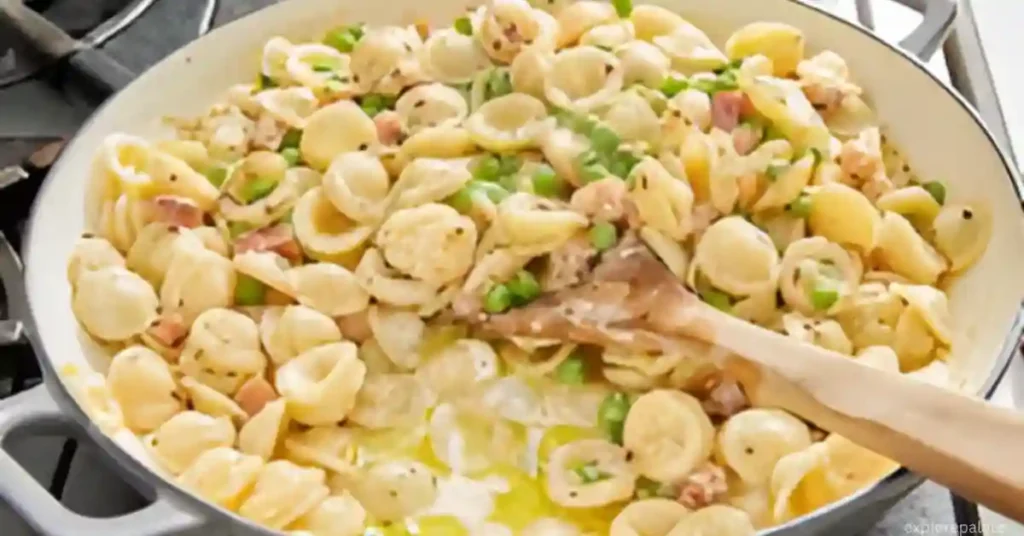
Cook the pancetta and veggies
In the realm of pasta, pancetta is king. My skillet hisses as I drizzle olive oil and let the pancetta sizzle over medium heat until its fat renders. The smell is intoxicating. It crisps up beautifully, and once done, I set it aside. In that same pan with rendered pancetta fat, shallots go in to become translucent, followed by thawed peas seasoned with salt, pepper, and a hint of red pepper flakes. Once they marry flavors, I scoop them out into a large bowl – the prelude to the creamy masterpiece we’re creating.
Make the sauce
In the now-familiar warmth of my kitchen, I ready the large skillet and pour in heavy cream and scallion whites, watching them come to a gentle simmer while I stand by, whisking lovingly. A pinch of nutmeg and a generous amount of Parmesan cheese join the dance until the melted cheese outlines my dreamy cream sauce. Back into this low heat concoction goes the pea mixture, integrating all under the soft glow of my stove light.
Boil the pasta
Meanwhile, a large pot of water is set to a rolling boil. I tip in the pasta, cooking until just al dente, knowing that pasta water is my secret weapon. Before draining the pasta through the colander, I remember to reserve a cup of the liquid gold – the pasta water – saving it from disappearing down the drain like so many forgotten recipes.
Bring it all together and serve
To finish, combine all comes together; the creamy sauce and pasta blend. If it’s too thick, just whispers of cream or saved pasta water will thin out to the desired consistency. As the liquid loosens the mixture, I fold in the noodles. To top it off, shredded and grated Parmesan cheese rained down like a culinary blessing, ready to serve.
Throughout this whole process, a thought lingers; my Instagram would reel in love with this SAUCY dish if only it could taste through the screen. Trust me, the pasta water, often disposed of, is the key ingredient to achieve that sauce that gloriously clings to the pasta instead of lying liquidy at the bottom of bowls. You learn with practice, but I promise you, mastering the art of the perfect consistency on the table means never facing the dread of dried up pasta again.
Expert Tips For Making This Pasta With Pancetta And Peas Recipe
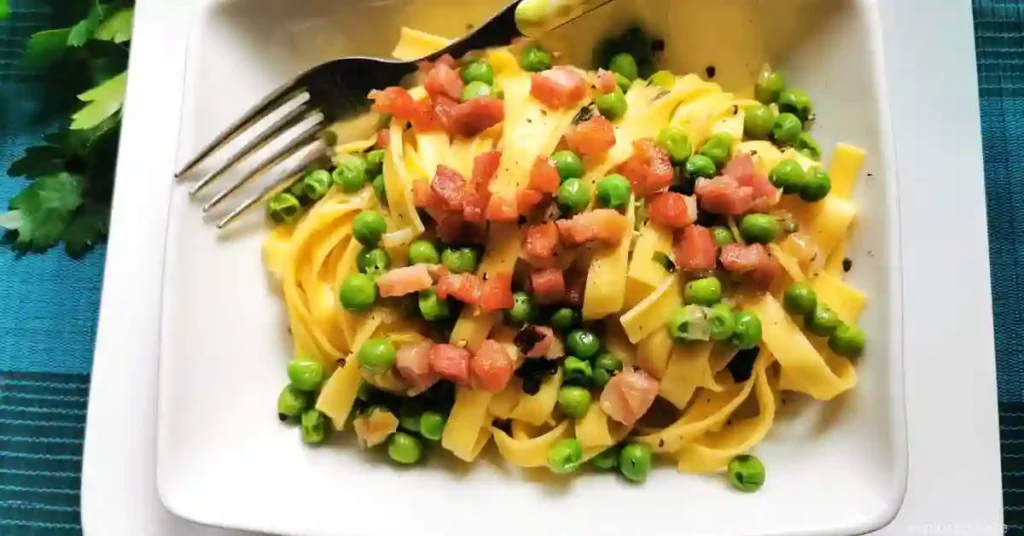
- Serve Immediately: The dish is best enjoyed fresh and does not reheat to the same velvety consistency.
- Timing Is Key: The creamy sauce cooks quickly and can burn if not watched closely.
- Deglaze the Pan: A splash of water in the pan can help in deglazing and incorporating the flavorful browned bits into the pea mixture.
- Avoid Overcooking: Overcooked sauces can lose their structure, take care to maintain the right consistency.
- Test Noodle Texture: Use a slotted spoon to check if the noodles are al dente, ensuring they’re not too mushy after draining.
- Drain Excess Fat: After cooking the pancetta, it’s wise to drain the excess fat though a paper towel might be needed.
- Lighter Fat Options: For a lighter sauce, use a touch of olive oil or switch from heavy cream to half and half.
- Fixing Thick Sauce: In case the cream sauce thickens too much, a little reserved pasta water or extra cream can help attain the desired consistency for reheating.
An important note about pasta water
I learned early on not to sprinkle but to pour when it comes to salt in pasta water; the reason? It creates a dynamic shift in what remained plain noodles into ones primed to absorb and coat with salty, flavorful sauce. Never waste that salty water; it’s a trick chefs value highly. A big pot with big handfuls of salt followed by boiling water; an incredible lesson retained from my days in culinary school.
An important tip: the time between when you strain and when your pasta hits the sauce is when the magic happens – it absorbs and seasons in mere moments. Don’t be scared to season; oily food scares off the flavor and oil will make the sauce stick poorly to the noodle. The big glug of oil I used to boil with the noodles at home? I’ve since learned, treat your salted water like the sea; that’s right, salt your water big – it’s your only chance to season the pasta from within before it could think to stick.
What To Serve With This Simple Pasta With Pancetta
Pair your Italian pasta marvel with a simple green salad, dressed in fresh lemon vinaigrette, to cut through the richness. A giant baguette with lots of butter, roasted broccoli with a squeeze of fresh lemon juice, or sauteed spinach and garlic will complement well. If protein is a must, consider baked chicken or roasted salmon to complete this feasting experience.
When To Serve Creamy Pasta With Pancetta And Peas

This peas and pancetta pasta dish fits any evening where food is both solace and celebration. Easter Sunday lunch, small dinner parties, or a delicious accompaniment to summer movie night. It’s a quick main course for a romantic pasta setting, ideal during times like Valentine’s Day dinner or in the middle of the week alongside a delicious recipe that graces the dinner table. Whether non-traditional or just for when you’re in the mood to post a stew-laden solo busy Friday, or an indulgent notion on a winter’s night, it’s truly a special occasions dish to enjoy whenever the craving hits.
Conclusion
In summation, the Creamy Parmesan Pasta with Pancetta and Peas serves as an emblem of comfort and culinary nostalgia, bridging my memories of family dinners in Atlanta with my current life in New York City. This dish, though simple in its assembly, is abundant in both flavor and emotion, capturing the essence of cherished home cooked meals and the exquisite simplicity of Italian cuisine enhanced by quality ingredients and culinary affection.
Reminiscent of the flavors in Elio’s Pasta, this recreation not only fills the stomach but also soothes the soul, offering a culinary hug that mitigates homesickness and turns a simple meal into an occasion of solace and joy. Whether served during a quiet weekend or as a soothing end to a bustling day, this pasta remains a testament to the power of food in bringing people together and creating unforgettable moments.
FAQs
Want some other sauces to try?
If you’re inspired to try a different sauce for your pasta, I’ve got just the recipes you’ll love. Remember that delicious basil and olive sauce I experimented with on a completely idle Tuesday? It’s a fast, original, and completely different way to enjoy pasta if you’re looking to try something other than the favorite creamy options. It’s a testimony to the love for different yet simple recipes that can transform the familiar into the extraordinary.
Made this recipe and loved it?
It makes my day to hear that you’ve made and loved the recipe. Don’t hesitate to leave a review and let me know your thoughts. Have you made any changes or adaptations? I would absolutely love to see a photo of it on Instagram! Go ahead and tag me in your post; it’s thrilling to hear how people love and put their own spin on my recipes.
What does pancetta pair well with?
The crispy texture of pancetta is versatile, going beyond just pasta. Try it in a salad with a light vinaigrette, or add a Parmesan and rosemary kick to popcorn. It’s also perfect in a charcuterie plate or stirred into scrambled eggs; the possibilities are countless.
Do you have to fully cook pancetta?
There’s often a misconception that you must fully cook pancetta. However, thanks to its curing process, it is often safe to consume in its raw state, much like prosciutto, before adding to a recipe. So, no, there’s no need to worry about it being fully cooked before eating.
How long does it take to cook pancetta?
The length of time to cook pancetta can be rather subjective. While it’s a cured meat and safe to eat raw, some prefer it crisp to enhance both texture and flavor. On average, it takes only a few minutes to reach that desirable crust on the outside, comparable to prosciutto.

